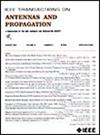Scattering Manipulation for Conformal Coding Metasurfaces Based on a Graphene-Assembled Film
IF 5.8
1区 计算机科学
Q1 ENGINEERING, ELECTRICAL & ELECTRONIC
引用次数: 0
Abstract
Electromagnetic (EM) scattering modulation on arbitrarily shaped platforms is crucial for practical communication systems. Metasurfaces offer significant potential because of their strong EM wave control capabilities. This article presents a conformal array scattering theory (CAST) for precise beam manipulation on 2-D conformal coding metasurfaces (CCMs). Due to the incident wave angle and the curved surface shape, elements exist scattering shadow regions. Therefore, we investigate the spatial direction and distribution of the scattering fields from subarrays composed of 1-bit elements, while analyzing the formation mechanism of the scattering shadow regions. By incorporating wave path and reflection phase changes induced by structural bending, we establish an accurate theoretical model to compute the far-field scattering pattern of CCMs. To validate the approach, a CCM based on a graphene-assembled film (GAF) with ultrahigh conductivity and excellent mechanical properties such as flexibility and lightweight is used to fabricate the designs. The flexible GAF can provide additional spatial freedom through structural bending, enabling curvature-based scattered beam manipulation without requiring other active devices. Theoretical analysis, simulations, and measurements show good agreement, demonstrating the potential of this method for designing conformal arrays for various curved platforms.基于石墨烯组装膜的共形编码超表面散射操纵
在实际通信系统中,任意形状平台上的电磁散射调制至关重要。由于其强大的电磁波控制能力,超表面提供了巨大的潜力。本文提出了一种用于二维共形编码元表面的精确光束操纵的共形阵列散射理论(CAST)。由于入射波角度和曲面形状的原因,元件存在散射阴影区。因此,我们研究了由1位元组成的子阵列散射场的空间方向和分布,同时分析了散射阴影区的形成机制。通过考虑结构弯曲引起的波程和反射相位变化,建立了精确计算ccm远场散射模式的理论模型。为了验证该方法,基于石墨烯组装膜(GAF)的CCM具有超高导电性和优异的机械性能,如柔韧性和轻质性,用于制造设计。柔性GAF可以通过结构弯曲提供额外的空间自由度,实现基于曲率的散射光束操作,而不需要其他主动设备。理论分析、仿真和测量结果显示了良好的一致性,证明了该方法在设计各种曲面平台的共形阵列方面的潜力。
本文章由计算机程序翻译,如有差异,请以英文原文为准。
求助全文
约1分钟内获得全文
求助全文
来源期刊
CiteScore
10.40
自引率
28.10%
发文量
968
审稿时长
4.7 months
期刊介绍:
IEEE Transactions on Antennas and Propagation includes theoretical and experimental advances in antennas, including design and development, and in the propagation of electromagnetic waves, including scattering, diffraction, and interaction with continuous media; and applications pertaining to antennas and propagation, such as remote sensing, applied optics, and millimeter and submillimeter wave techniques

 求助内容:
求助内容: 应助结果提醒方式:
应助结果提醒方式:


